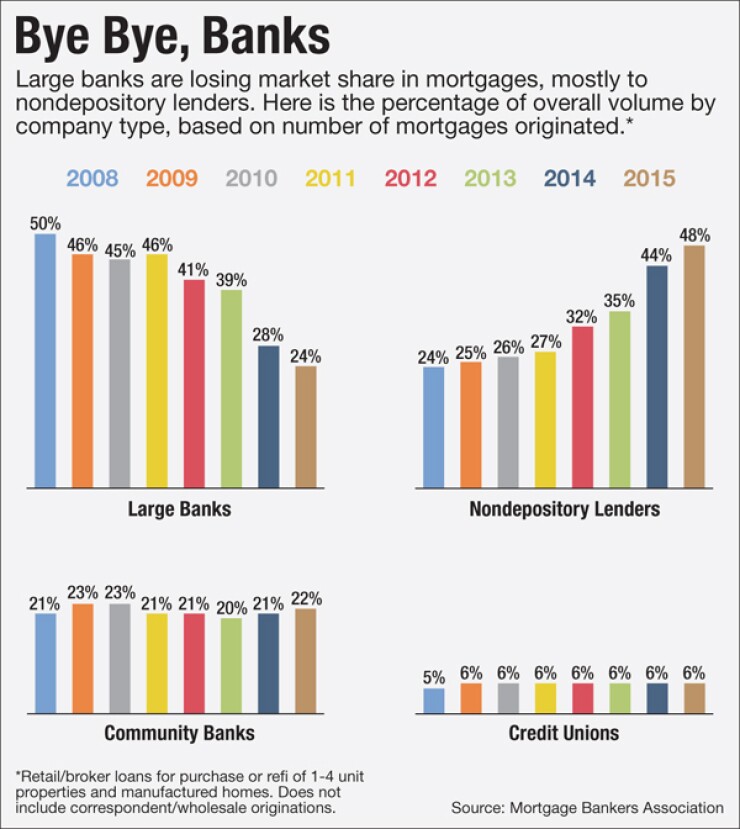
The digital mortgage is more of an ideal than it is a concrete product.
While precise definitions vary, the term generally describes a smooth customer experience that may not even require a phone call or branch visit. It could be an intuitive process for applying for a loan online, perhaps with prepopulated data to save on typing. Borrowers upload financial documents and electronically sign disclosures. It can go as far as a fully paperless experience where all documents are executed electronically.
Embracing the concept can provide a competitive advantage in the mortgage market at a time when nonbanks are gobbling up banks' share of originations.
Digital mortgages are different than e-mortgages, which have been around for more than a decade. The latter term refers specifically to a loan that is backed by an electronic promissory note with an electronic signature. Digital mortgages may sometimes meet that definition, and they may have electronic closings. What makes them distinctive, though, is not the technological gizmos involved but the end result for the borrower.
"I would describe that as the capability to provide a mortgage experience for a borrower from application all the way to funding without human intervention on the lender's side," said John Harrell, vice president of mortgage product management at USAA Bank. "I don't know if that will ever be widespread, but if that's the goal then we'll end up having a ton of automation where the consumer is basically self-serving."
Self-service is the idea behind Quicken Loans' Rocket Mortgage, introduced in November 2015. Consumers enter personal information — such as their income and the banks where they have accounts — into a website or mobile app. Rocket Mortgage combines that with information it collects, retrieving bank statements, pay stubs and other documentation. This reduces the turnaround time for a loan by what it says is an average of eight days.
"Forever the burden of proof was on a consumer — you could tell a mortgage banker about your finances and then you had to prove it by producing all these documents you never use," said Regis Hadiaris, the Rocket Mortgage product lead at Quicken Loans. "We're focused on our clients and delivering an experience that makes sense for them."
In the first nine months of 2016, Rocket Mortgage funded more than $5 billion in loan volume, according to Quicken Loans. If it were a stand-alone company, Rocket Mortgage would rank as a top-30 lender.
E-closings are another way to fulfill the goal of the broader digital mortgage project. A study released in August 2015 by the Consumer Financial Protection Bureau found that, compared with consumers who closed a mortgage using paper documents, e-closing borrowers felt more in control, thought they understood better what was going on and found the process more efficient.
The industry has been slow to adopt e-closings due to a host of factors, including regulations that vary from state to state and some investors' distaste for the loans because of the perceived risk. But court decisions in 2016 affirmed that lenders can enforce a paperless mortgage as they would a traditional one in foreclosure proceedings — boding well for growth.
Residential Mortgage Corp., a midsize lender based in Fayetteville, N.C., recently completed its first e-closing. It took 15 minutes of the borrower's time, rather than the usual hour and a half, according to Mary Bright, vice president of operations at the company. "Customer service is the key for a midsize lender when you're competing with a bank," Bright said. "In order for us to compete with that, the only thing we can offer is customer service, such as quicker closings."
Notice that neither Quicken Loans nor Residential Mortgage is a depository. "The pace at which nonbanks can innovate is far greater than that of the banks," said Josh Smallwood, vice president of software development at the residential mortgage lender Guaranteed Rate. "Nonbanks can actually move, change and pivot much quicker than the banks can."
One disadvantage for banks is that their mortgage divisions have to compete with other business lines for funding and resources. "The mortgage business inside a bank tends to be one of the less understood businesses," USAA's Harrell said. "They just want the mortgage business to print income for them. They don't see it as an investment."
Quicken Loans, by contrast, devoted 500 information technology employees exclusively to its Rocket Mortgage for three years.
Large banks' share of origination volume, by number of loans, dropped by about half, to 24%, between 2008 and 2015, according to Home Mortgage Disclosure Act data compiled by the Mortgage Bankers Association. Over the same period, the share written by nondepositories has doubled to 48%. (Community banks' percentage of the market hovered in the low 20s during this period.)
In addition to making the process more attractive to consumers, technology can make mortgages cheaper for banks to originate, further helping them to compete. "This process is much less expensive," said Jeff Bode, owner and chief executive of Mid America Mortgage, an independent lender based in Addison, Texas. "If your IT department can't do this significantly cheaper than what you're doing with paper, there's something wrong."





